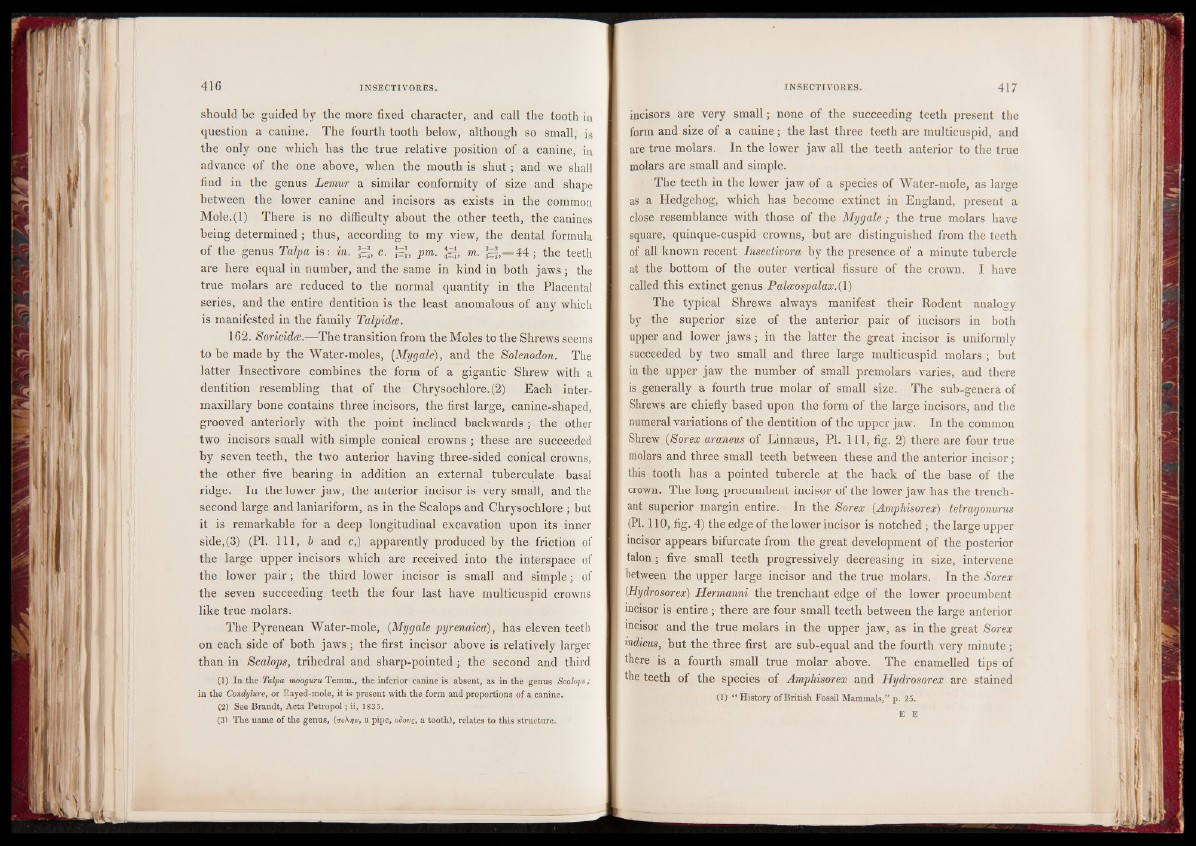
should be guided by the more fixed character, and call the tooth in
question a canine. The fourth tooth below, although so small, is
the only one which has the true relative position of a canine, in
advance of the one above, when the mouth is shut; and we shall
find in the genus Lemur a similar conformity of size and shape
between the lower canine and incisors as exists in the common
Mole.(l) There is no difficulty about the other teeth, the canines
being determined ; thus, according to my view, the dental formula
of the genus Talpa is: in. gj, c. £1, pm. *t~, m. g ,= 4 4 ; the teeth
are here equal in number, and the same in kind in both jaws; the
true molars are reduced to the normal quantity in the Placental
series, and the entire dentition is the least anomalous of any which
is manifested in the family Talpidce.
162. Smcw&Bf|-The transition from the Moles to the Shrews seems
to he made by the Water-moles, [Mygale), and the Solenodon. The
latter Insectivore combines the form of a gigantic Shrew with a
dentition resembling that of the Chrysochlore.(2) Each intermaxillary
bone contains three incisors, the first large, canine-shaped,
grooved anteriorly with the point inclined backwards; the other
two incisors small with simple conical crowns ; these are succeeded
by seven teeth, the two anterior having three-sided conical crowns,
the other five bearing in addition an external tuberculate basal
ridge. In the lower jaw, the anterior incisor is very small, and the
second large and laniariform, as in the Scalopsand Chrysochlore ; but
it is remarkable for a deep longitudinal excavation upon its inner
side,(3) (PI. Ill, b and c,) apparently produced by the friction of
the large upper incisors which are received into the interspace of
the lower pair; the third lower incisor is small and simple; of
the seven succeeding teeth the four last have multicuspid crowns
like true molars.
The Pyrenean Water-mole, (Mygale pyrenaica), has eleven teeth
on each side of both jaws; the first incisor above is relatively larger
than in Scalops, trihedral and sharp-pointed ; the second and third
(1) In the Talpa mooguru Temm., the inferior canine is absent, as in the genus Scalops;
in the Condylure, or Rayed-mole, it is present with the form and proportions of a canine.
(2) See Brandt, Acta Petropol; ii, 1835.
(31 The name of the genus, (<ro\riv, a pipe, odovg, a tooth), relates to this structure.
incisors are very small; none of the succeeding teeth present the
form and size of a canine; the last three teeth are multicuspid, and
are true molars. In the lower jaw all the teeth anterior to the true
molars are small and simple.
The teeth in the lower jaw of a species of Water-mole, as large
as a Hedgehog, which has become extinct in England, present a
close resemblance with those of the Mygale; the true molars have
square, quinque-cuspid crowns, hut are distinguished from the teeth
of all known recent Insectivora by the presence of a minute tubercle
at the bottom of the outer vertical fissure of the crown. I have
called this extinct genus Palceospalax.( 1)
The typical Shrews always manifest their Rodent analogy
by the superior size of the anterior pair of incisors in both
upper and lower jaws; in the latter the great incisor is uniformly
succeeded by two small and three large multicuspid molars ; but
in the upper jaw the number of small premolars varies, and there
is generally a fourth true molar of small size. The sub-genera of
Shrews are chiefly based upon the form of the large incisors, and the
numeral variations of the dentition of the upper jaw. In the common
Shrew (Sorex araneus of Linnaeus, PI. Ill, fig. 2) there are four true
molars and three small teeth between these and the anterior incisor;
this tooth has a pointed tubercle at the back of the base of the
crown. The long procumbent incisor of the lower jaw has the trenchant
superior margin entire. In the Sorex (Amphisorex) tetragonurus
(PI. 110, fig. 4) the edge of the lower incisor is notched, the large upper
incisor appears bifurcate from the great development of the posterior
talon; five small teeth progressively decreasing in size, intervene
between the upper large incisor and the true molars. In the Sorex
(Hydrosorex) Hermanni the trenchant edge of the lower procumbent
incisor is entire; there are four small teeth between the large anterior
incisor and the true molars in the upper jaw, as in the great Sorex
indicus, but the three first are sub-equal and the fourth very minute ;
there is a fourth small true molar above. The enamelled tips of
the teeth of the species of Amphisorex and Hydrosorex are stained
(1) “ History of British Fossil Mammals,” p. 25.
E E